Research Proposal: Equality and Diversity Impact on Employee Retention
VerifiedAdded on 2023/01/10
|14
|2856
|65
Project
AI Summary
This research proposal investigates the impact of managing cultural diversity on employee retention within a business, using Sainsbury's as a case study. The study aims to explore the role of managing cultural diversity, identify challenges faced by companies in managing diverse cultures, and determine effective strategies for maintaining diversity in the workplace. The research will employ a positivism research philosophy and a deductive research approach, utilizing a survey strategy with a questionnaire to gather quantitative data. The proposal outlines the research activities, including literature review, data collection, analysis, and the expected timeline. It also details the research methodology, including the research onion framework, and discusses sampling techniques and ethical considerations. The proposal concludes with a Gantt chart illustrating the project timeline and a reference list of relevant literature.

Research Project
Paraphrase This Document
Need a fresh take? Get an instant paraphrase of this document with our AI Paraphraser

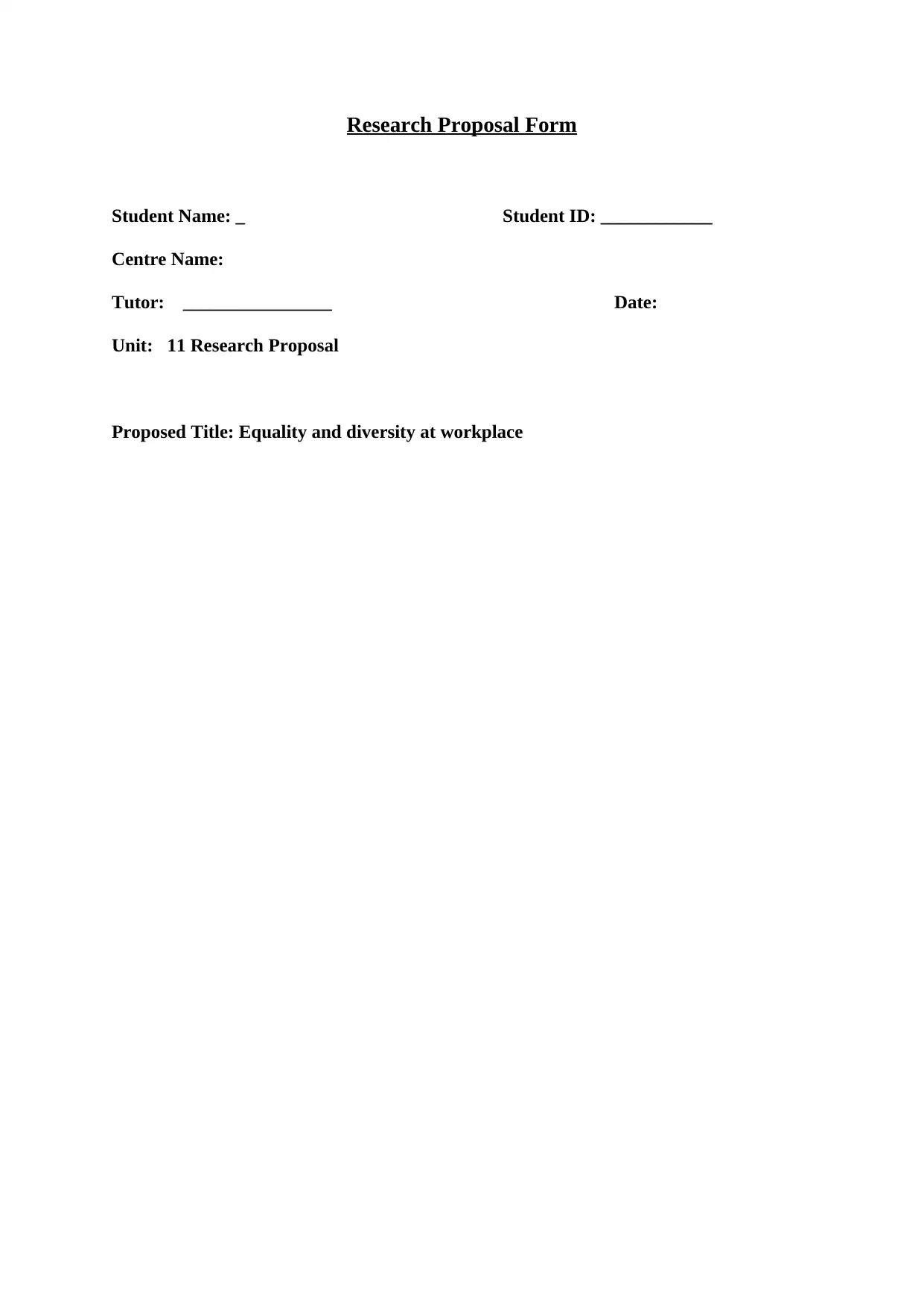
Research Proposal Form
Student Name: _ Student ID: ____________
Centre Name:
Tutor: ________________ Date:
Unit: 11 Research Proposal
Proposed Title: Equality and diversity at workplace
Student Name: _ Student ID: ____________
Centre Name:
Tutor: ________________ Date:
Unit: 11 Research Proposal
Proposed Title: Equality and diversity at workplace
⊘ This is a preview!⊘
Do you want full access?
Subscribe today to unlock all pages.

Trusted by 1+ million students worldwide
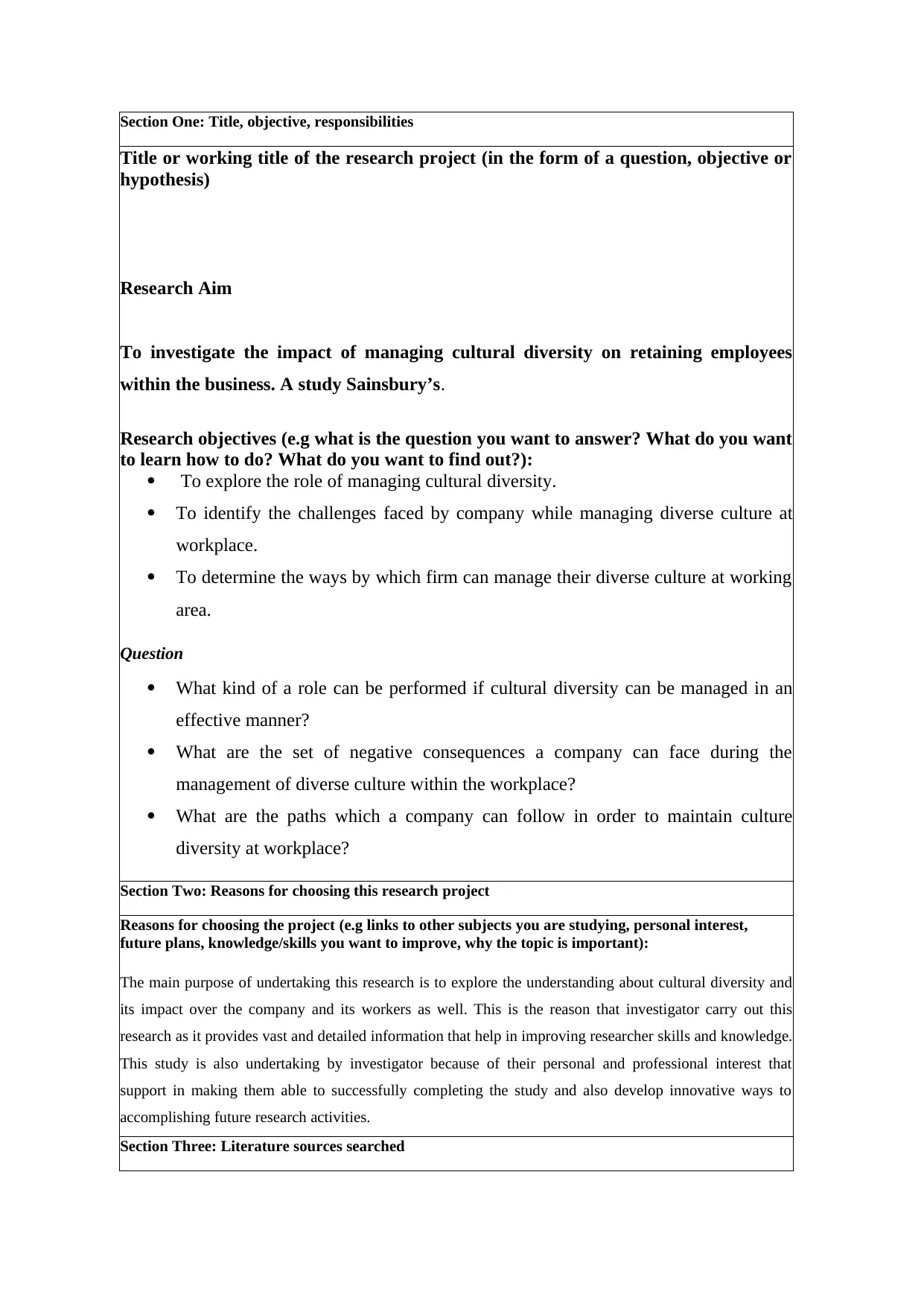
Section One: Title, objective, responsibilities
Title or working title of the research project (in the form of a question, objective or
hypothesis)
Research Aim
To investigate the impact of managing cultural diversity on retaining employees
within the business. A study Sainsbury’s.
Research objectives (e.g what is the question you want to answer? What do you want
to learn how to do? What do you want to find out?):
To explore the role of managing cultural diversity.
To identify the challenges faced by company while managing diverse culture at
workplace.
To determine the ways by which firm can manage their diverse culture at working
area.
Question
What kind of a role can be performed if cultural diversity can be managed in an
effective manner?
What are the set of negative consequences a company can face during the
management of diverse culture within the workplace?
What are the paths which a company can follow in order to maintain culture
diversity at workplace?
Section Two: Reasons for choosing this research project
Reasons for choosing the project (e.g links to other subjects you are studying, personal interest,
future plans, knowledge/skills you want to improve, why the topic is important):
The main purpose of undertaking this research is to explore the understanding about cultural diversity and
its impact over the company and its workers as well. This is the reason that investigator carry out this
research as it provides vast and detailed information that help in improving researcher skills and knowledge.
This study is also undertaking by investigator because of their personal and professional interest that
support in making them able to successfully completing the study and also develop innovative ways to
accomplishing future research activities.
Section Three: Literature sources searched
Title or working title of the research project (in the form of a question, objective or
hypothesis)
Research Aim
To investigate the impact of managing cultural diversity on retaining employees
within the business. A study Sainsbury’s.
Research objectives (e.g what is the question you want to answer? What do you want
to learn how to do? What do you want to find out?):
To explore the role of managing cultural diversity.
To identify the challenges faced by company while managing diverse culture at
workplace.
To determine the ways by which firm can manage their diverse culture at working
area.
Question
What kind of a role can be performed if cultural diversity can be managed in an
effective manner?
What are the set of negative consequences a company can face during the
management of diverse culture within the workplace?
What are the paths which a company can follow in order to maintain culture
diversity at workplace?
Section Two: Reasons for choosing this research project
Reasons for choosing the project (e.g links to other subjects you are studying, personal interest,
future plans, knowledge/skills you want to improve, why the topic is important):
The main purpose of undertaking this research is to explore the understanding about cultural diversity and
its impact over the company and its workers as well. This is the reason that investigator carry out this
research as it provides vast and detailed information that help in improving researcher skills and knowledge.
This study is also undertaking by investigator because of their personal and professional interest that
support in making them able to successfully completing the study and also develop innovative ways to
accomplishing future research activities.
Section Three: Literature sources searched
Paraphrase This Document
Need a fresh take? Get an instant paraphrase of this document with our AI Paraphraser
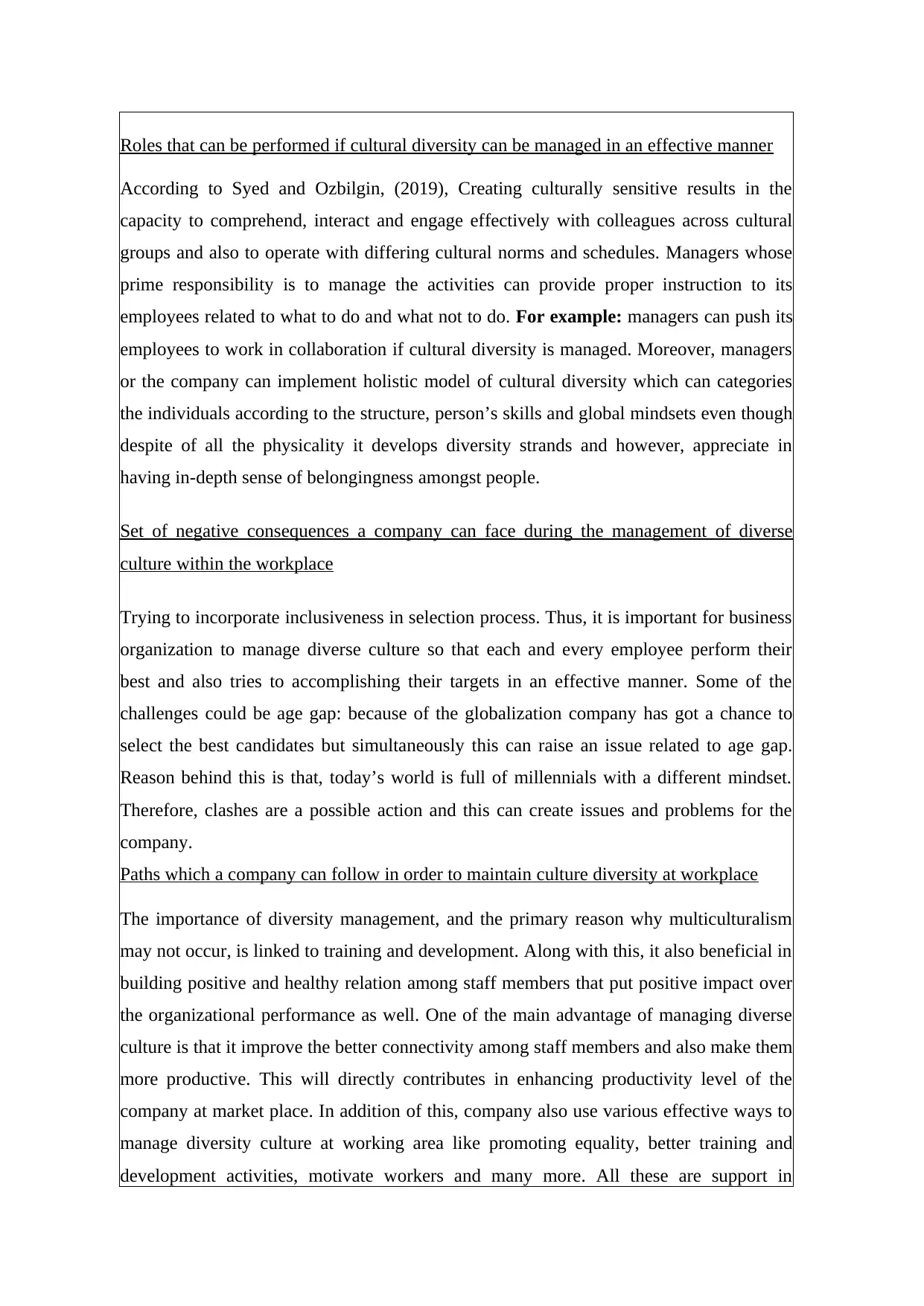
Roles that can be performed if cultural diversity can be managed in an effective manner
According to Syed and Ozbilgin, (2019), Creating culturally sensitive results in the
capacity to comprehend, interact and engage effectively with colleagues across cultural
groups and also to operate with differing cultural norms and schedules. Managers whose
prime responsibility is to manage the activities can provide proper instruction to its
employees related to what to do and what not to do. For example: managers can push its
employees to work in collaboration if cultural diversity is managed. Moreover, managers
or the company can implement holistic model of cultural diversity which can categories
the individuals according to the structure, person’s skills and global mindsets even though
despite of all the physicality it develops diversity strands and however, appreciate in
having in-depth sense of belongingness amongst people.
Set of negative consequences a company can face during the management of diverse
culture within the workplace
Trying to incorporate inclusiveness in selection process. Thus, it is important for business
organization to manage diverse culture so that each and every employee perform their
best and also tries to accomplishing their targets in an effective manner. Some of the
challenges could be age gap: because of the globalization company has got a chance to
select the best candidates but simultaneously this can raise an issue related to age gap.
Reason behind this is that, today’s world is full of millennials with a different mindset.
Therefore, clashes are a possible action and this can create issues and problems for the
company.
Paths which a company can follow in order to maintain culture diversity at workplace
The importance of diversity management, and the primary reason why multiculturalism
may not occur, is linked to training and development. Along with this, it also beneficial in
building positive and healthy relation among staff members that put positive impact over
the organizational performance as well. One of the main advantage of managing diverse
culture is that it improve the better connectivity among staff members and also make them
more productive. This will directly contributes in enhancing productivity level of the
company at market place. In addition of this, company also use various effective ways to
manage diversity culture at working area like promoting equality, better training and
development activities, motivate workers and many more. All these are support in
According to Syed and Ozbilgin, (2019), Creating culturally sensitive results in the
capacity to comprehend, interact and engage effectively with colleagues across cultural
groups and also to operate with differing cultural norms and schedules. Managers whose
prime responsibility is to manage the activities can provide proper instruction to its
employees related to what to do and what not to do. For example: managers can push its
employees to work in collaboration if cultural diversity is managed. Moreover, managers
or the company can implement holistic model of cultural diversity which can categories
the individuals according to the structure, person’s skills and global mindsets even though
despite of all the physicality it develops diversity strands and however, appreciate in
having in-depth sense of belongingness amongst people.
Set of negative consequences a company can face during the management of diverse
culture within the workplace
Trying to incorporate inclusiveness in selection process. Thus, it is important for business
organization to manage diverse culture so that each and every employee perform their
best and also tries to accomplishing their targets in an effective manner. Some of the
challenges could be age gap: because of the globalization company has got a chance to
select the best candidates but simultaneously this can raise an issue related to age gap.
Reason behind this is that, today’s world is full of millennials with a different mindset.
Therefore, clashes are a possible action and this can create issues and problems for the
company.
Paths which a company can follow in order to maintain culture diversity at workplace
The importance of diversity management, and the primary reason why multiculturalism
may not occur, is linked to training and development. Along with this, it also beneficial in
building positive and healthy relation among staff members that put positive impact over
the organizational performance as well. One of the main advantage of managing diverse
culture is that it improve the better connectivity among staff members and also make them
more productive. This will directly contributes in enhancing productivity level of the
company at market place. In addition of this, company also use various effective ways to
manage diversity culture at working area like promoting equality, better training and
development activities, motivate workers and many more. All these are support in
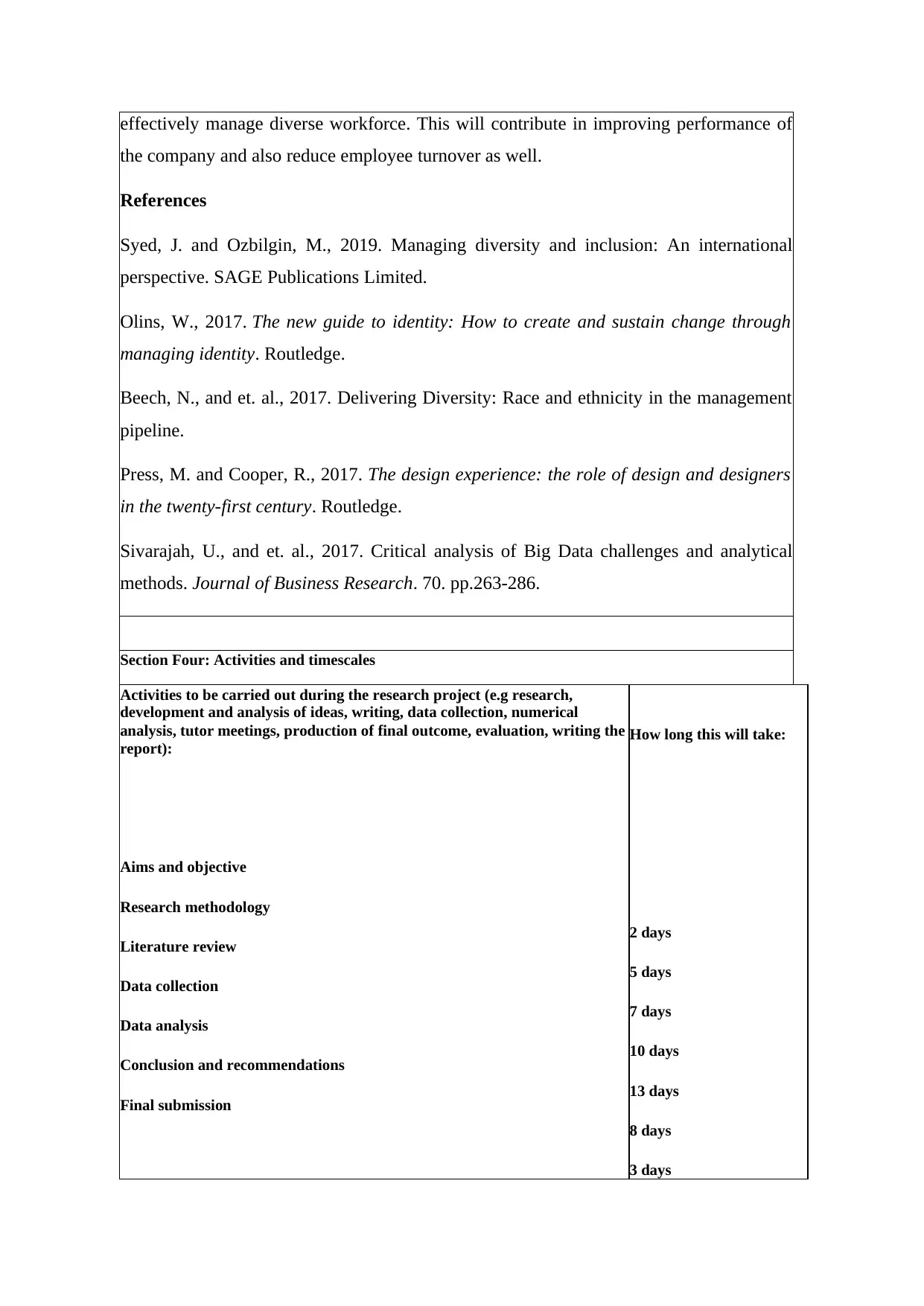
effectively manage diverse workforce. This will contribute in improving performance of
the company and also reduce employee turnover as well.
References
Syed, J. and Ozbilgin, M., 2019. Managing diversity and inclusion: An international
perspective. SAGE Publications Limited.
Olins, W., 2017. The new guide to identity: How to create and sustain change through
managing identity. Routledge.
Beech, N., and et. al., 2017. Delivering Diversity: Race and ethnicity in the management
pipeline.
Press, M. and Cooper, R., 2017. The design experience: the role of design and designers
in the twenty-first century. Routledge.
Sivarajah, U., and et. al., 2017. Critical analysis of Big Data challenges and analytical
methods. Journal of Business Research. 70. pp.263-286.
Section Four: Activities and timescales
Activities to be carried out during the research project (e.g research,
development and analysis of ideas, writing, data collection, numerical
analysis, tutor meetings, production of final outcome, evaluation, writing the
report):
Aims and objective
Research methodology
Literature review
Data collection
Data analysis
Conclusion and recommendations
Final submission
How long this will take:
2 days
5 days
7 days
10 days
13 days
8 days
3 days
the company and also reduce employee turnover as well.
References
Syed, J. and Ozbilgin, M., 2019. Managing diversity and inclusion: An international
perspective. SAGE Publications Limited.
Olins, W., 2017. The new guide to identity: How to create and sustain change through
managing identity. Routledge.
Beech, N., and et. al., 2017. Delivering Diversity: Race and ethnicity in the management
pipeline.
Press, M. and Cooper, R., 2017. The design experience: the role of design and designers
in the twenty-first century. Routledge.
Sivarajah, U., and et. al., 2017. Critical analysis of Big Data challenges and analytical
methods. Journal of Business Research. 70. pp.263-286.
Section Four: Activities and timescales
Activities to be carried out during the research project (e.g research,
development and analysis of ideas, writing, data collection, numerical
analysis, tutor meetings, production of final outcome, evaluation, writing the
report):
Aims and objective
Research methodology
Literature review
Data collection
Data analysis
Conclusion and recommendations
Final submission
How long this will take:
2 days
5 days
7 days
10 days
13 days
8 days
3 days
⊘ This is a preview!⊘
Do you want full access?
Subscribe today to unlock all pages.

Trusted by 1+ million students worldwide
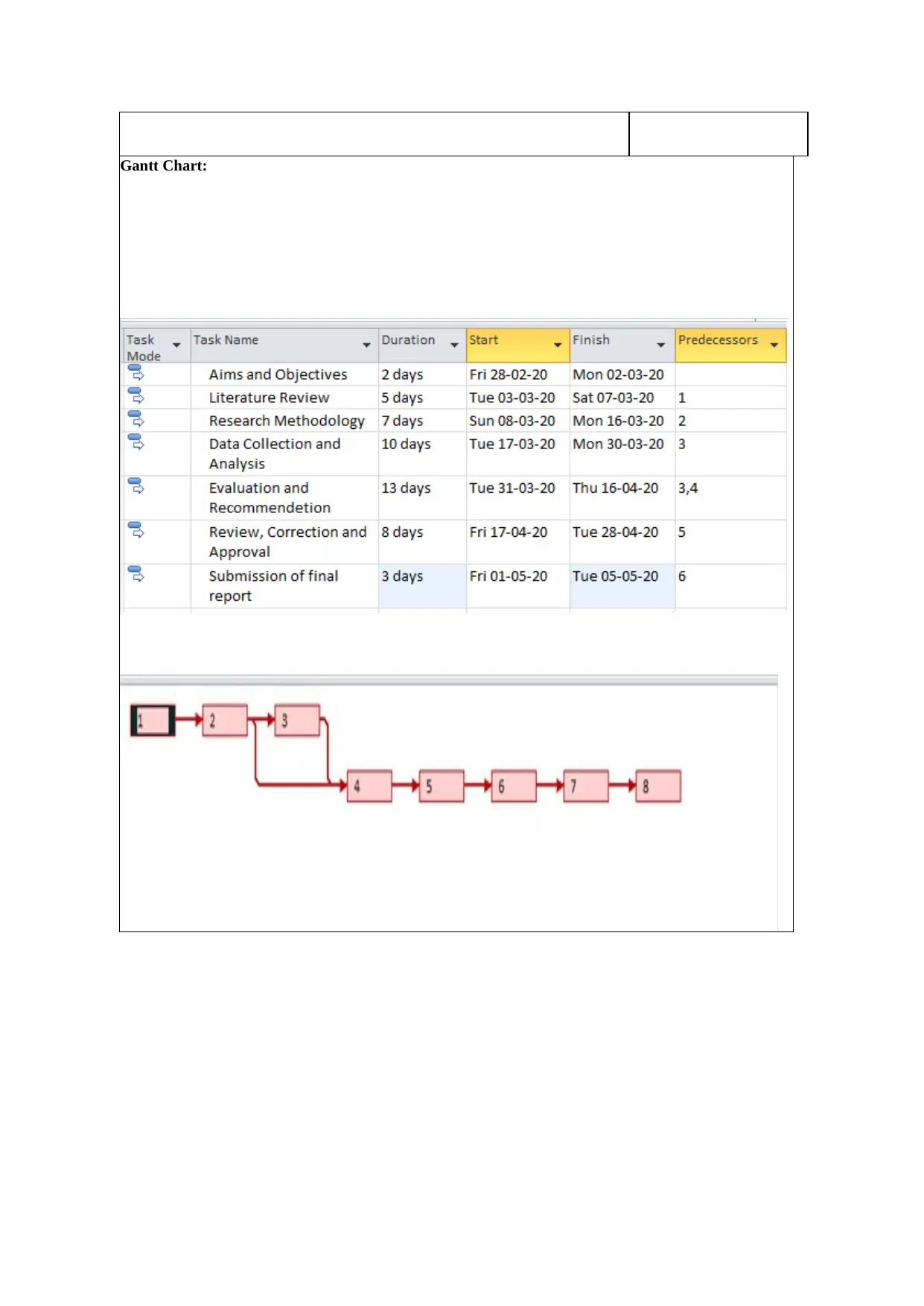
Gantt Chart:
Paraphrase This Document
Need a fresh take? Get an instant paraphrase of this document with our AI Paraphraser
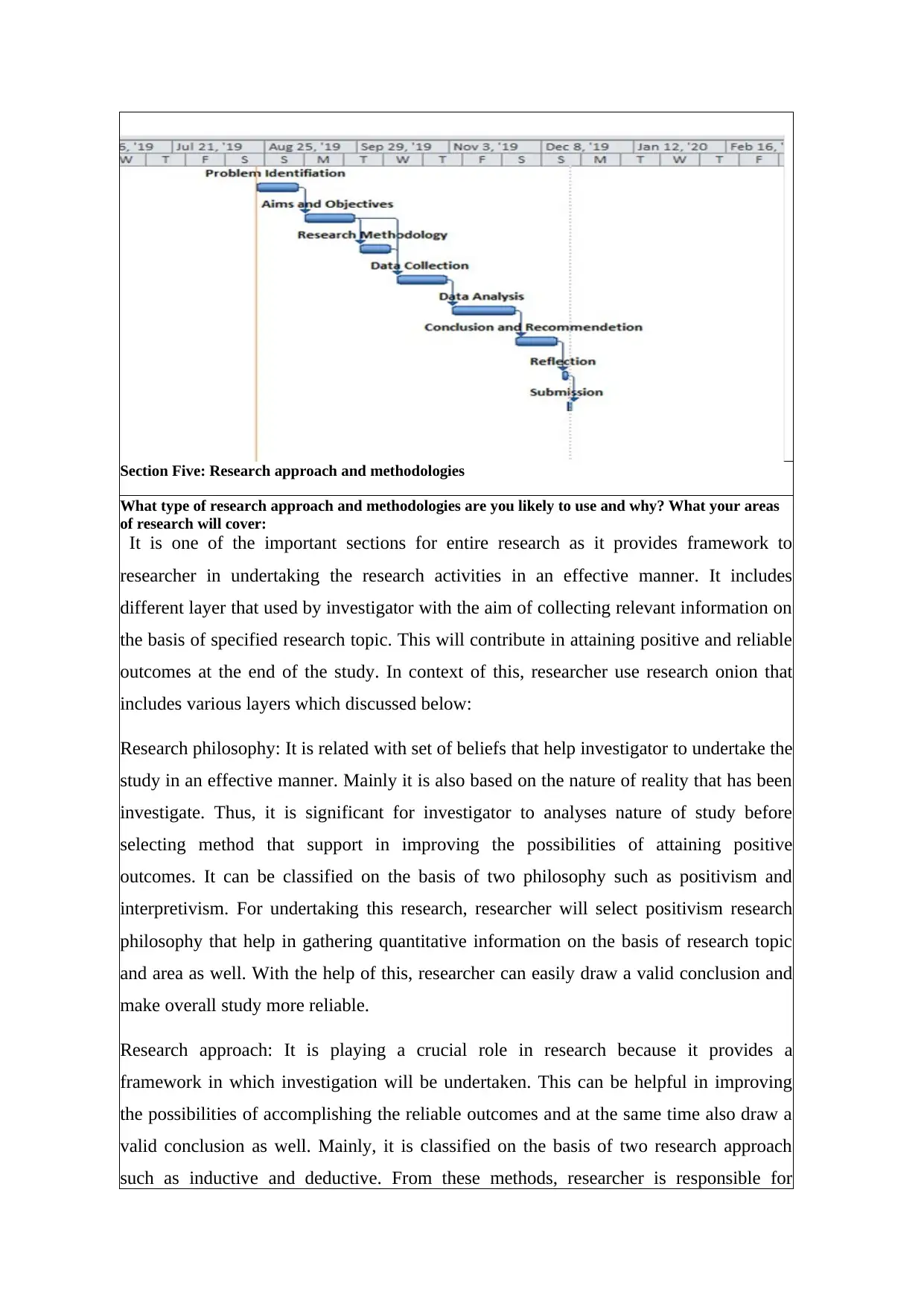
Section Five: Research approach and methodologies
What type of research approach and methodologies are you likely to use and why? What your areas
of research will cover:
It is one of the important sections for entire research as it provides framework to
researcher in undertaking the research activities in an effective manner. It includes
different layer that used by investigator with the aim of collecting relevant information on
the basis of specified research topic. This will contribute in attaining positive and reliable
outcomes at the end of the study. In context of this, researcher use research onion that
includes various layers which discussed below:
Research philosophy: It is related with set of beliefs that help investigator to undertake the
study in an effective manner. Mainly it is also based on the nature of reality that has been
investigate. Thus, it is significant for investigator to analyses nature of study before
selecting method that support in improving the possibilities of attaining positive
outcomes. It can be classified on the basis of two philosophy such as positivism and
interpretivism. For undertaking this research, researcher will select positivism research
philosophy that help in gathering quantitative information on the basis of research topic
and area as well. With the help of this, researcher can easily draw a valid conclusion and
make overall study more reliable.
Research approach: It is playing a crucial role in research because it provides a
framework in which investigation will be undertaken. This can be helpful in improving
the possibilities of accomplishing the reliable outcomes and at the same time also draw a
valid conclusion as well. Mainly, it is classified on the basis of two research approach
such as inductive and deductive. From these methods, researcher is responsible for
What type of research approach and methodologies are you likely to use and why? What your areas
of research will cover:
It is one of the important sections for entire research as it provides framework to
researcher in undertaking the research activities in an effective manner. It includes
different layer that used by investigator with the aim of collecting relevant information on
the basis of specified research topic. This will contribute in attaining positive and reliable
outcomes at the end of the study. In context of this, researcher use research onion that
includes various layers which discussed below:
Research philosophy: It is related with set of beliefs that help investigator to undertake the
study in an effective manner. Mainly it is also based on the nature of reality that has been
investigate. Thus, it is significant for investigator to analyses nature of study before
selecting method that support in improving the possibilities of attaining positive
outcomes. It can be classified on the basis of two philosophy such as positivism and
interpretivism. For undertaking this research, researcher will select positivism research
philosophy that help in gathering quantitative information on the basis of research topic
and area as well. With the help of this, researcher can easily draw a valid conclusion and
make overall study more reliable.
Research approach: It is playing a crucial role in research because it provides a
framework in which investigation will be undertaken. This can be helpful in improving
the possibilities of accomplishing the reliable outcomes and at the same time also draw a
valid conclusion as well. Mainly, it is classified on the basis of two research approach
such as inductive and deductive. From these methods, researcher is responsible for
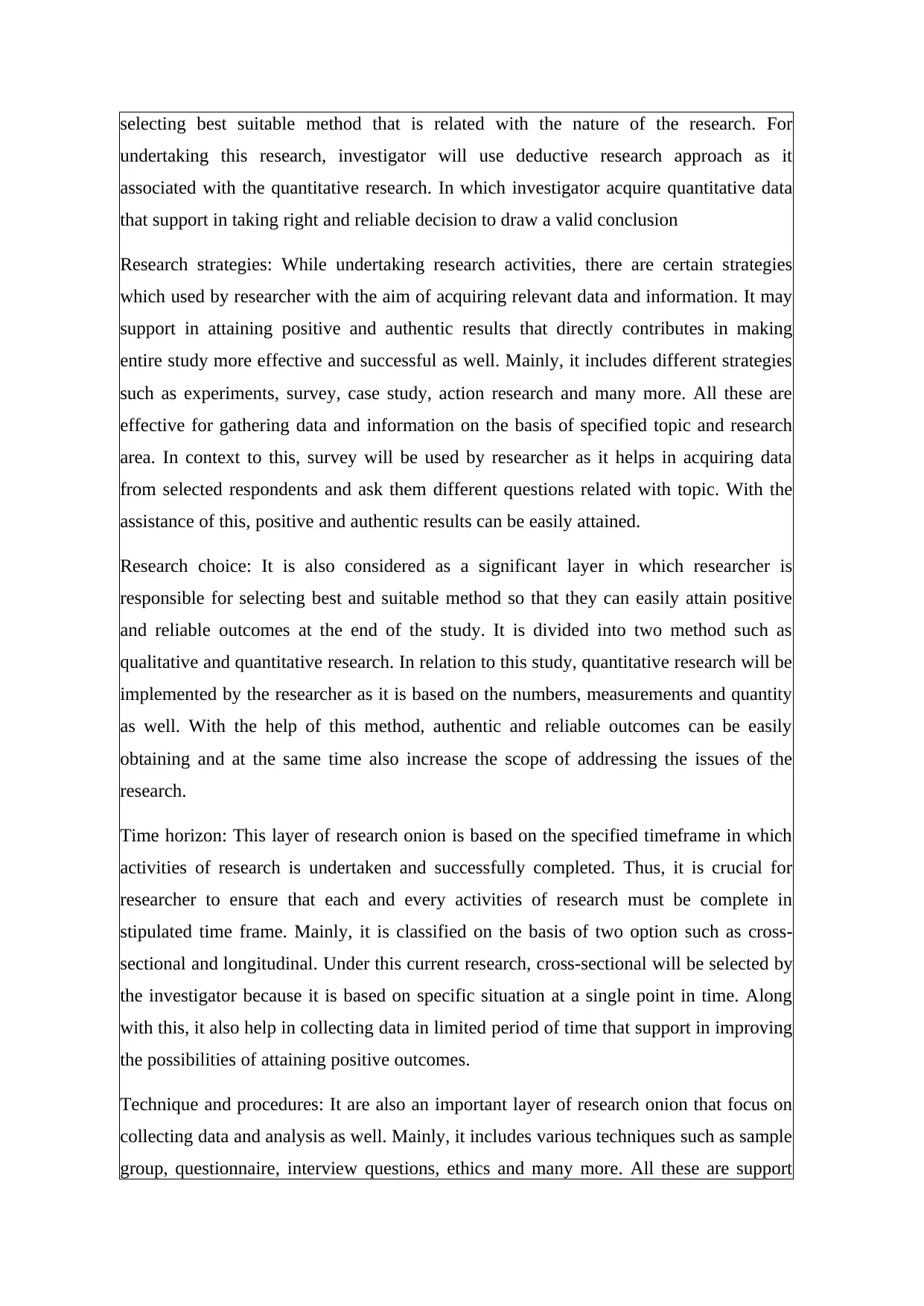
selecting best suitable method that is related with the nature of the research. For
undertaking this research, investigator will use deductive research approach as it
associated with the quantitative research. In which investigator acquire quantitative data
that support in taking right and reliable decision to draw a valid conclusion
Research strategies: While undertaking research activities, there are certain strategies
which used by researcher with the aim of acquiring relevant data and information. It may
support in attaining positive and authentic results that directly contributes in making
entire study more effective and successful as well. Mainly, it includes different strategies
such as experiments, survey, case study, action research and many more. All these are
effective for gathering data and information on the basis of specified topic and research
area. In context to this, survey will be used by researcher as it helps in acquiring data
from selected respondents and ask them different questions related with topic. With the
assistance of this, positive and authentic results can be easily attained.
Research choice: It is also considered as a significant layer in which researcher is
responsible for selecting best and suitable method so that they can easily attain positive
and reliable outcomes at the end of the study. It is divided into two method such as
qualitative and quantitative research. In relation to this study, quantitative research will be
implemented by the researcher as it is based on the numbers, measurements and quantity
as well. With the help of this method, authentic and reliable outcomes can be easily
obtaining and at the same time also increase the scope of addressing the issues of the
research.
Time horizon: This layer of research onion is based on the specified timeframe in which
activities of research is undertaken and successfully completed. Thus, it is crucial for
researcher to ensure that each and every activities of research must be complete in
stipulated time frame. Mainly, it is classified on the basis of two option such as cross-
sectional and longitudinal. Under this current research, cross-sectional will be selected by
the investigator because it is based on specific situation at a single point in time. Along
with this, it also help in collecting data in limited period of time that support in improving
the possibilities of attaining positive outcomes.
Technique and procedures: It are also an important layer of research onion that focus on
collecting data and analysis as well. Mainly, it includes various techniques such as sample
group, questionnaire, interview questions, ethics and many more. All these are support
undertaking this research, investigator will use deductive research approach as it
associated with the quantitative research. In which investigator acquire quantitative data
that support in taking right and reliable decision to draw a valid conclusion
Research strategies: While undertaking research activities, there are certain strategies
which used by researcher with the aim of acquiring relevant data and information. It may
support in attaining positive and authentic results that directly contributes in making
entire study more effective and successful as well. Mainly, it includes different strategies
such as experiments, survey, case study, action research and many more. All these are
effective for gathering data and information on the basis of specified topic and research
area. In context to this, survey will be used by researcher as it helps in acquiring data
from selected respondents and ask them different questions related with topic. With the
assistance of this, positive and authentic results can be easily attained.
Research choice: It is also considered as a significant layer in which researcher is
responsible for selecting best and suitable method so that they can easily attain positive
and reliable outcomes at the end of the study. It is divided into two method such as
qualitative and quantitative research. In relation to this study, quantitative research will be
implemented by the researcher as it is based on the numbers, measurements and quantity
as well. With the help of this method, authentic and reliable outcomes can be easily
obtaining and at the same time also increase the scope of addressing the issues of the
research.
Time horizon: This layer of research onion is based on the specified timeframe in which
activities of research is undertaken and successfully completed. Thus, it is crucial for
researcher to ensure that each and every activities of research must be complete in
stipulated time frame. Mainly, it is classified on the basis of two option such as cross-
sectional and longitudinal. Under this current research, cross-sectional will be selected by
the investigator because it is based on specific situation at a single point in time. Along
with this, it also help in collecting data in limited period of time that support in improving
the possibilities of attaining positive outcomes.
Technique and procedures: It are also an important layer of research onion that focus on
collecting data and analysis as well. Mainly, it includes various techniques such as sample
group, questionnaire, interview questions, ethics and many more. All these are support
⊘ This is a preview!⊘
Do you want full access?
Subscribe today to unlock all pages.

Trusted by 1+ million students worldwide
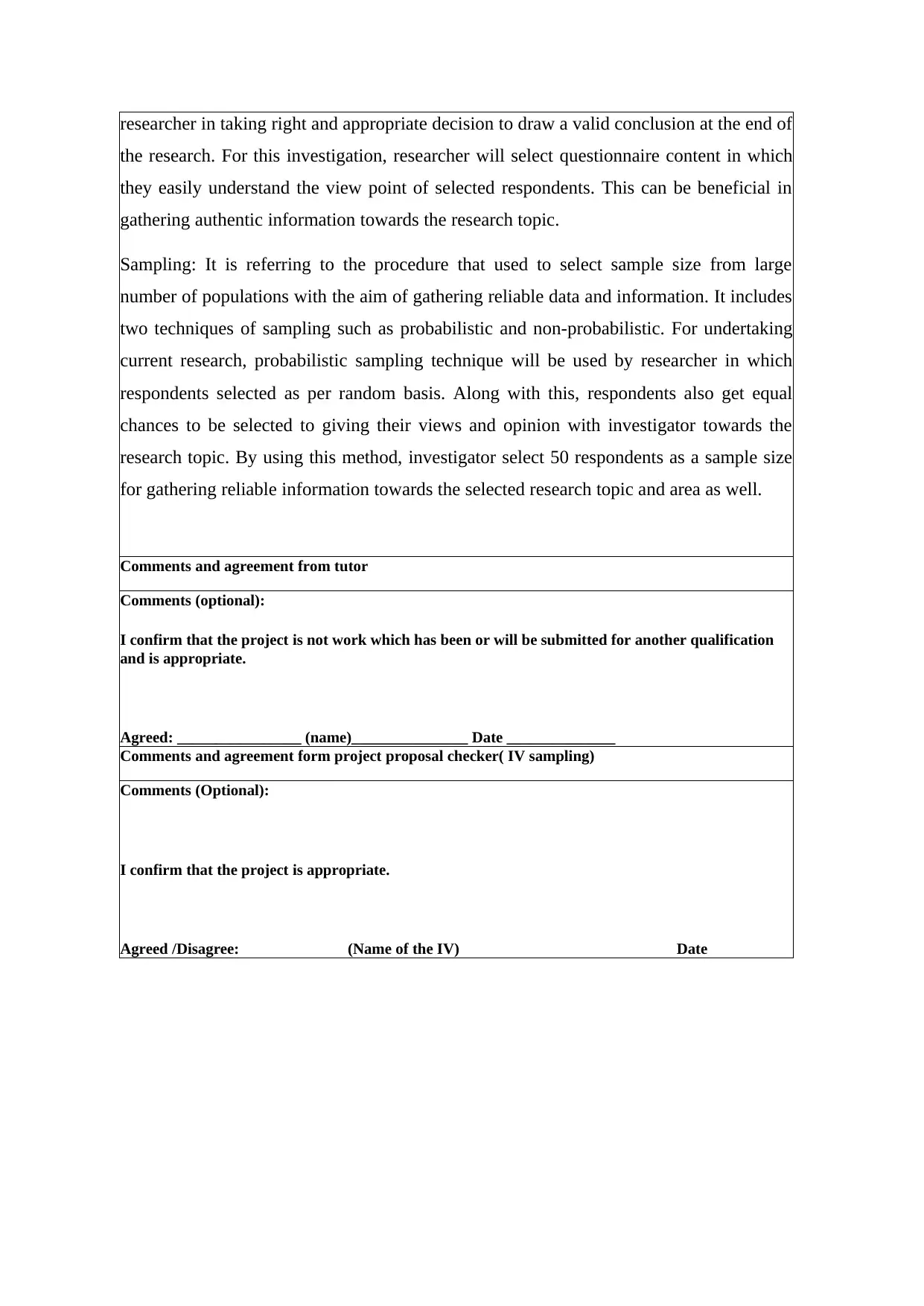
researcher in taking right and appropriate decision to draw a valid conclusion at the end of
the research. For this investigation, researcher will select questionnaire content in which
they easily understand the view point of selected respondents. This can be beneficial in
gathering authentic information towards the research topic.
Sampling: It is referring to the procedure that used to select sample size from large
number of populations with the aim of gathering reliable data and information. It includes
two techniques of sampling such as probabilistic and non-probabilistic. For undertaking
current research, probabilistic sampling technique will be used by researcher in which
respondents selected as per random basis. Along with this, respondents also get equal
chances to be selected to giving their views and opinion with investigator towards the
research topic. By using this method, investigator select 50 respondents as a sample size
for gathering reliable information towards the selected research topic and area as well.
Comments and agreement from tutor
Comments (optional):
I confirm that the project is not work which has been or will be submitted for another qualification
and is appropriate.
Agreed: ________________ (name)_______________ Date ______________
Comments and agreement form project proposal checker( IV sampling)
Comments (Optional):
I confirm that the project is appropriate.
Agreed /Disagree: (Name of the IV) Date
the research. For this investigation, researcher will select questionnaire content in which
they easily understand the view point of selected respondents. This can be beneficial in
gathering authentic information towards the research topic.
Sampling: It is referring to the procedure that used to select sample size from large
number of populations with the aim of gathering reliable data and information. It includes
two techniques of sampling such as probabilistic and non-probabilistic. For undertaking
current research, probabilistic sampling technique will be used by researcher in which
respondents selected as per random basis. Along with this, respondents also get equal
chances to be selected to giving their views and opinion with investigator towards the
research topic. By using this method, investigator select 50 respondents as a sample size
for gathering reliable information towards the selected research topic and area as well.
Comments and agreement from tutor
Comments (optional):
I confirm that the project is not work which has been or will be submitted for another qualification
and is appropriate.
Agreed: ________________ (name)_______________ Date ______________
Comments and agreement form project proposal checker( IV sampling)
Comments (Optional):
I confirm that the project is appropriate.
Agreed /Disagree: (Name of the IV) Date
Paraphrase This Document
Need a fresh take? Get an instant paraphrase of this document with our AI Paraphraser
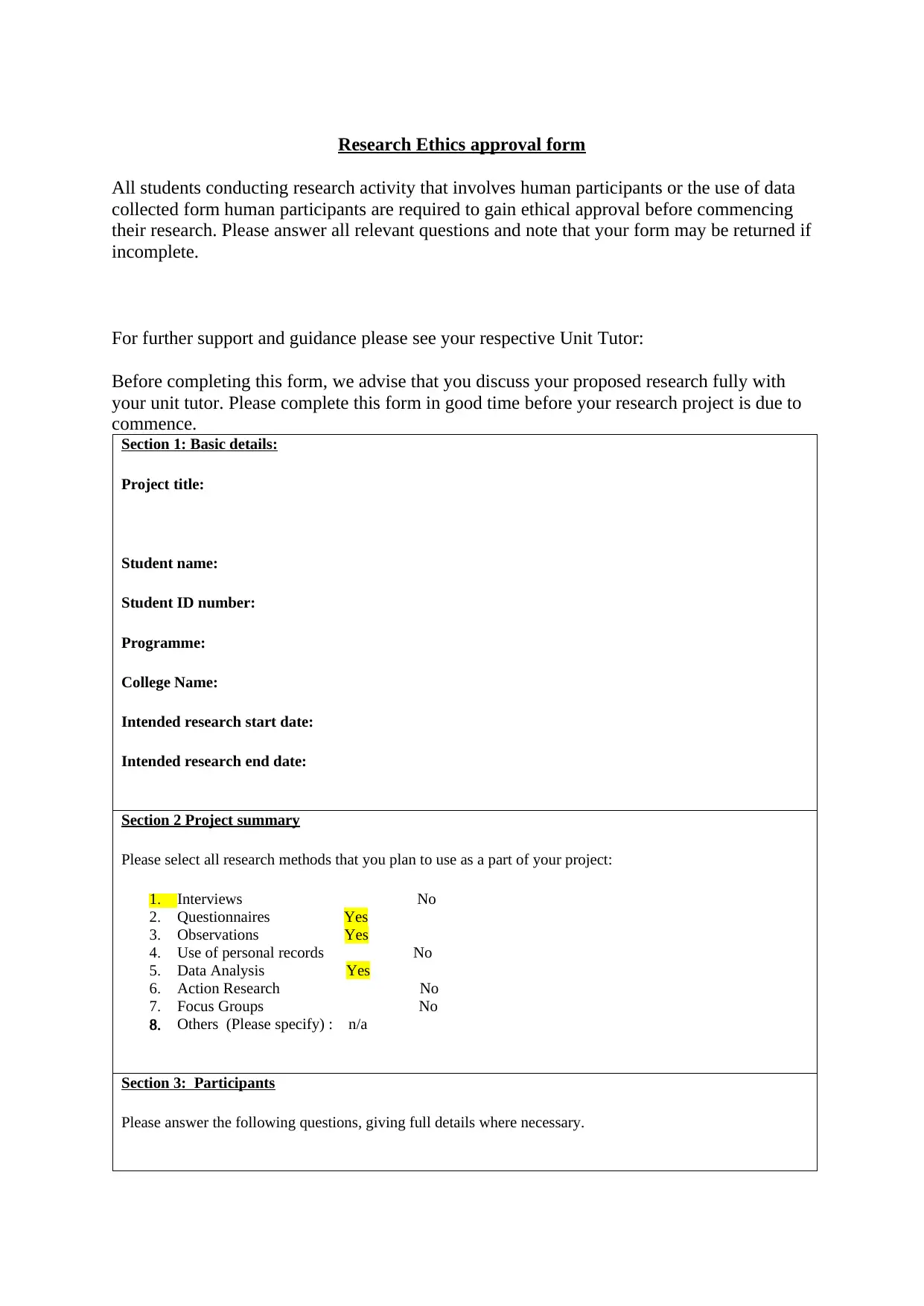
Research Ethics approval form
All students conducting research activity that involves human participants or the use of data
collected form human participants are required to gain ethical approval before commencing
their research. Please answer all relevant questions and note that your form may be returned if
incomplete.
For further support and guidance please see your respective Unit Tutor:
Before completing this form, we advise that you discuss your proposed research fully with
your unit tutor. Please complete this form in good time before your research project is due to
commence.
Section 1: Basic details:
Project title:
Student name:
Student ID number:
Programme:
College Name:
Intended research start date:
Intended research end date:
Section 2 Project summary
Please select all research methods that you plan to use as a part of your project:
1. Interviews No
2. Questionnaires Yes
3. Observations Yes
4. Use of personal records No
5. Data Analysis Yes
6. Action Research No
7. Focus Groups No
8. Others (Please specify) : n/a
Section 3: Participants
Please answer the following questions, giving full details where necessary.
All students conducting research activity that involves human participants or the use of data
collected form human participants are required to gain ethical approval before commencing
their research. Please answer all relevant questions and note that your form may be returned if
incomplete.
For further support and guidance please see your respective Unit Tutor:
Before completing this form, we advise that you discuss your proposed research fully with
your unit tutor. Please complete this form in good time before your research project is due to
commence.
Section 1: Basic details:
Project title:
Student name:
Student ID number:
Programme:
College Name:
Intended research start date:
Intended research end date:
Section 2 Project summary
Please select all research methods that you plan to use as a part of your project:
1. Interviews No
2. Questionnaires Yes
3. Observations Yes
4. Use of personal records No
5. Data Analysis Yes
6. Action Research No
7. Focus Groups No
8. Others (Please specify) : n/a
Section 3: Participants
Please answer the following questions, giving full details where necessary.
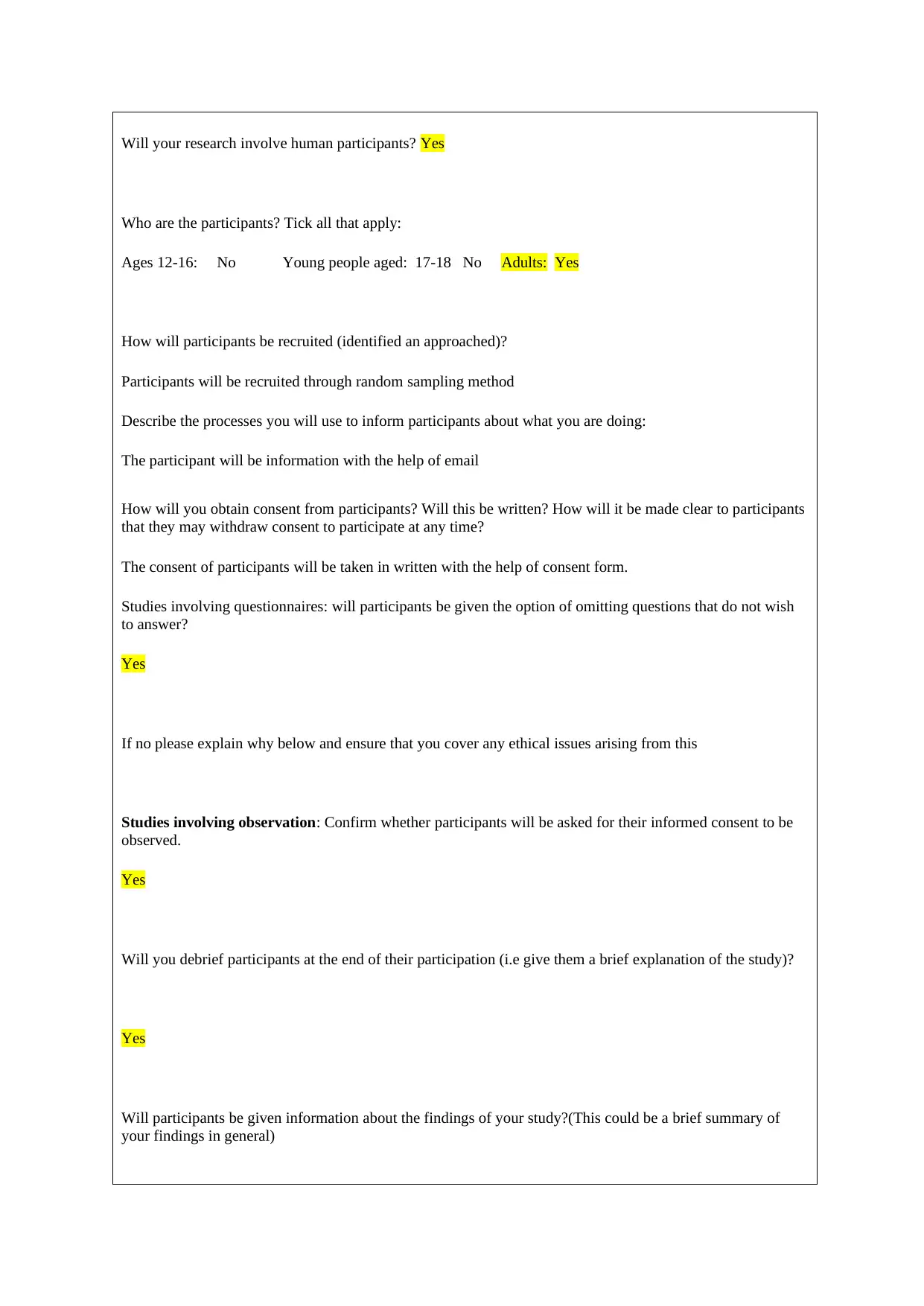
Will your research involve human participants? Yes
Who are the participants? Tick all that apply:
Ages 12-16: No Young people aged: 17-18 No Adults: Yes
How will participants be recruited (identified an approached)?
Participants will be recruited through random sampling method
Describe the processes you will use to inform participants about what you are doing:
The participant will be information with the help of email
How will you obtain consent from participants? Will this be written? How will it be made clear to participants
that they may withdraw consent to participate at any time?
The consent of participants will be taken in written with the help of consent form.
Studies involving questionnaires: will participants be given the option of omitting questions that do not wish
to answer?
Yes
If no please explain why below and ensure that you cover any ethical issues arising from this
Studies involving observation: Confirm whether participants will be asked for their informed consent to be
observed.
Yes
Will you debrief participants at the end of their participation (i.e give them a brief explanation of the study)?
Yes
Will participants be given information about the findings of your study?(This could be a brief summary of
your findings in general)
Who are the participants? Tick all that apply:
Ages 12-16: No Young people aged: 17-18 No Adults: Yes
How will participants be recruited (identified an approached)?
Participants will be recruited through random sampling method
Describe the processes you will use to inform participants about what you are doing:
The participant will be information with the help of email
How will you obtain consent from participants? Will this be written? How will it be made clear to participants
that they may withdraw consent to participate at any time?
The consent of participants will be taken in written with the help of consent form.
Studies involving questionnaires: will participants be given the option of omitting questions that do not wish
to answer?
Yes
If no please explain why below and ensure that you cover any ethical issues arising from this
Studies involving observation: Confirm whether participants will be asked for their informed consent to be
observed.
Yes
Will you debrief participants at the end of their participation (i.e give them a brief explanation of the study)?
Yes
Will participants be given information about the findings of your study?(This could be a brief summary of
your findings in general)
⊘ This is a preview!⊘
Do you want full access?
Subscribe today to unlock all pages.

Trusted by 1+ million students worldwide
1 out of 14
Related Documents
Your All-in-One AI-Powered Toolkit for Academic Success.
+13062052269
info@desklib.com
Available 24*7 on WhatsApp / Email
![[object Object]](/_next/static/media/star-bottom.7253800d.svg)
Unlock your academic potential
Copyright © 2020–2025 A2Z Services. All Rights Reserved. Developed and managed by ZUCOL.





